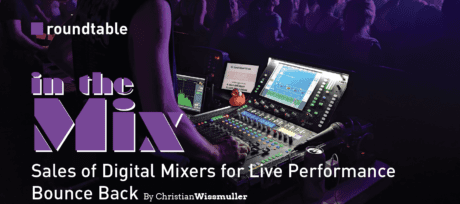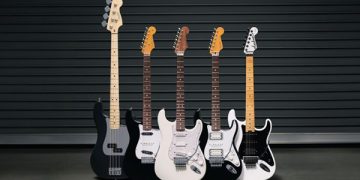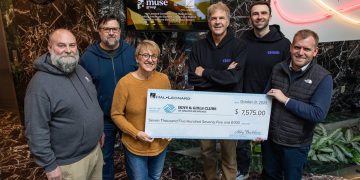 A segment of MI hit particularly hard during the pandemic and COVID-related restrictions on large, in-person gatherings, digital mixing consoles have been gaining momentum as venues of all sizes continue to return to something approaching “normal.” With ever-evolving technology driving innovation in this space, digital mixers are more feature-rich, intuitive, and powerful than ever before.
A segment of MI hit particularly hard during the pandemic and COVID-related restrictions on large, in-person gatherings, digital mixing consoles have been gaining momentum as venues of all sizes continue to return to something approaching “normal.” With ever-evolving technology driving innovation in this space, digital mixers are more feature-rich, intuitive, and powerful than ever before.
MMR checked in with four major suppliers of this gear to learn about what specific models are best-sellers so far in 2023, how successful MI retailers are displaying and marketing mixers, and other significant trends in this area.
For your brand what model (or models) of digital mixers are currently top-sellers?
Jeff Hawley: We’ve been amazed at the tremendous sales velocity of our entire range over the last few years. As MMRreaders know, Allen & Heath grabbed the first MMR Dealers’ Choice Award for a digital mixer with our SQ five years ago and we’ve been honored with the award ever since. Two years in a row for SQ and now three years in a row for Avantis. These lines have been huge hits for us and we’ve continued to offer free major updates to SQ and Avantis that are largely driven by user feedback and requests via our user forum and social media pages. I’d also want to highlight the CTi1500 and the entire dLive range which has grown by leaps and bounds on the touring front and opened up a new market for touring engineers who want to own an affordable and flyable tour rig. Depending on your definition of ‘digital mixers’, the AHM series has also been a top seller on the digital installed matrix side of things with the recent expansion of the line with the AHM-16 and AHM-32 joining the AHM-64. We’ve seen really interesting applications of this series, especially in installed projects that require especially high quality critical audio performance specifications. If I had to pick just one model as the key top seller to check out in Allen & Heath land, I’d go with Avantis.
Preston Gray: As the pioneer of digital consoles, Yamaha boasts high performing market share & recognition across numerous systems. The flagship Rivage class of consoles curates renowned performances on some of the largest world tours, while the CL & QL class consoles are the most trusted workhorses across thousands of venues & events. Yamaha has made digital consoles accessible for various users, including musicians and bands, and has high performing market share with the easy-to-use and operate TF series! With the most recent launch of the new DM3 series, early demand has soared and indicates it will be a top seller in its class of ultra-compact mixers!
Jon Graves: I would like to say that we are a real player in the mixer market, but we only have three models. We have a TouchMix-8, 16, and 30, and all of them are crushing. Our TouchMixers are very unique. It’s a super high-quality mixer. It’s not cheap, but it’s not crazy expensive. They’re small, but we made them with all the grown-up features that a big mixer has. And then we put a bunch of cool features in there to help novices learn how to mix. We like to say that the QSC TouchMix is the only mixer that guarantees results. We’ve put a bunch of time into covering a wide breadth of customer.
Adrian Haselhuber: All of our StudioLive Series III digital mixers are doing very well at the moment, especially compact models like the StudioLive 32SC.
Paul Youngblood: TASCAM has a long, rich legacy of large format digital consoles but has focused on other products the last several years. That said, TASCAM just released the Sonicview 24XP and Sonicview 16XP mid to large format professional state-of-the-art products. Sonicview products are combination live, recording, and broadcast consoles. We pre-released Sonicview in Japan and so far they are a huge hit, especially the broadcast market. We expect the same in the U.S.
Have you been noticing any significant trends when it comes to what features, et cetera are being sought-after by buyers when it comes to these products?
PG: The primary purpose of a digital console is to curate and amplify music and art. Engineers and musicians are looking for tools that can quickly and reliably build a mix that is sure to get them their next gig. Tools like One-Knob presets and quick-config setup to automate patching allows the musician to focus on what matters most, creating music rather than digging thru setup menus. We also notice that sonic quality is critical when amplifying music. While this can be achieved by increasing sample rates to 96kHz, greater studies are achieved through purpose-built processing such as EQ, dynamics and summing algorithms designed with music at the center of the development process, not just in a lab or behind a computer screen. When mixing and amplifying music, it makes sense to trust a company that lives and breathes music to ensure every note and transient is heard the way it’s intended.
JG: There are some shifts that happened as we’ve come out of the pandemic and bands started playing again. Before I came to QSC I was a front-of-house guy and a record producer for 35 years, so I mixed big bands for a long time. My job here is to bring all those things that we used to use in a large tuning format and try and make them accessible to the end user, from the novice all the way up to the pro. What I do see is a more upscale concern in some respects for the people that are out playing today. In other words, we see more and more bands that are wanting to carry a TouchMix-30 because they want to do their own in-ear mix. And the TouchMix-30 is a super badass mixer for that because its features are crazy. It’s 14 aux out, so that’s seven stereo ear mixes, plus processing on all the outputs. Most mixers at this level don’t have all of that stuff that we have in here. I think people are seriously looking for value. I just think post-pandemic people are looking a little more closely at exactly what they’re doing and what they’re buying.
PY: Smaller format footprints with expansion capability for I/O and Dante compatibility. We see more and more Dante-based usage in house of worship, universities, large concert venues, broadcast, and more. That is why TASCAM included Dante as a standard feature in Sonicview. We simultaneously developed Sonicview with a Dante-based stage box called SB-16D. SB-16D has 16 inputs, and 16 outputs which is unusual in a stage box. SB-16D has 16 outputs for maximum capability to flow audio back to the stage or studio for use with in ear monitors, headphone mixes, and stage monitoring.
AH: Our customers range from individual musicians to touring bands or installations at houses of worship, and as such have different sets of requirements. All users appreciate how quickly and easily our consoles can be integrated into many different workflows, ranging from typical live FOH mixing to music recording in studios. I would say that some of the trends we continue to see across the board include high I/O density in smaller form factors, very good sound quality at affordable prices, and making it easy for anyone to get up to speed quickly – even if you are not a trained mixing engineer.
JH: As I mentioned, the CTi1500 has been a hit with touring engineers since it offers high channel counts and a rich feature set in a lightweight compact form factor. I’d say the trend toward compact flyable rigs is a significant one. As the CTi1500 comes in at just 25.4lbs, it now opens up options for checking your console control surface and engine as baggage — a 96kHz 160×64 FPGA core ultra-low latency beast alongside your suitcase. A number of major touring engineers and tour managers have messaged me to say that checking their entire audio control package on flights is a game changer.
I’d also note that the conversation around the benefits of 96kHz audio within the live sound space seems to have moved to a point where this higher sample rate is now simply table stakes. We can debate the finer points all day long (a fun hobby of mine!), but it seems that the market has spoken and 96kHz is the new standard for anything new that is being released in the pro digital live console market these days. For dealers out there that are looking to step into the digital live console space or expand their offerings there, I’d put lightweight flyable options and 96kHz sample rate operation at the top of the product line requirements list.
I’ll speak more to this later, but I’d also add robust support and top-notch training/commissioning as a core requirement for any live sound manufacturer. We’re rather proud of our dedicated US service facility and repair team and the wonderful live humans in our support team promptly returning calls and tackling support tickets. I’d certainly say that our quick and easy and consistent support is a key ‘feature’ that garners a lot of positive feedback from dealers and engineers of all levels, especially in contrast to other companies who may not offer such a ‘feature’ at this time. The snazziest live console in the world that misbehaves when you need it most is just a giant paperweight without an adequate support network in place.
In your estimation, has live performance fully returned to pre-pandemic numbers, or are we not completely “out of the woods” yet?
JG: No, we’re not there. But, there are some aspects of live performance that are bigger than they were in 2019. We’re seeing tons more singer-songwriter duets, for example, and places that didn’t necessarily always have live music now do to some extent. During the pandemic there were clubs and restaurants that were moving stuff outside, and one of the things that they could do is put a singer-songwriter outside. So, there are little niches that kind of are clearly back to where they were, maybe a little busier. But from the standpoint of mainstream stuff we saw in 2019, I think you’re probably still challenged there because there’s some venues that went away. But I don’t feel like it’s hurting desperately. I think it’s charging back – it’s certainly not going backwards.
PY: Live performance both major and minor are back. Demand and ticket prices are higher than ever.
AH: We are seeing very good recovery of the live sound equipment market with strong demand for mixing consoles, PA speakers, and other related equipment. If we look at the number of live concert tickets sold as a leading indicator, I would say it’s safe to assume that we are well on our way to a full recovery this year.
JH: I think I’d make a bit of a distinction here between live performance writ large (tours, live concerts, non-musical live events, corporate, et cetera) and the pro AV manufacturer market. Based on a number of industry reports, it does look like we are trending back to pre-pandemic levels as far as folks like MSG (Madison Square Garden) and Live Nation are concerned. Some of the more mid-tier and smaller venues are still not quite back to pre-pandemic levels based on other reports and anecdotal evidence I’ve come across. A bit of a mixed bag when we look at the actual numbers, but what isn’t mixed is the desire for folks to get out and experience live events. Live performances are tracking well and I expect things to shift here and there overall, but return to pre-pandemic levels soon. Perhaps one other significant trend to note here is the emergence of immersive audio and a higher demand for really top-notch audio overall. People want to experience live music and they really want to experience live music in new ways.
From the pro AV market side of things there seems to be a bit of lingering pandemic and supply chain ripple effects out there. We’ve been fortunate to weather these storms quite well and come out the other side in a great overall position. I don’t think it is a surprise for dealers to read here that not every provider in the live sound space (and wider pro AV market) has been able to return to a normal pre-pandemic footing yet. Again, I think we’re getting close to being over the key hurdles as an industry and Allen & Heath is certainly continuing to move lots of product at a steady rate with very few exceptions at this time.
PG: Absolutely! Music connects people. Music travels through sound waves. Waves move us. They are born when players find harmony with their instruments, and the energy and emotion they create are shared with an audience. These are the moments where stories are passed on, obstacles and challenges overcome, new beauty discovered, and friendships are made.
Are there any “best practices” when it comes to display, marketing, and promotion that you’ve observed successful MI retailers adopting when it comes to selling digital mixers?
AH: Since StudioLive consoles all have a multitrack SD card, a great way to display them is to playback a multitrack session from the SD card and have a pair of headphones or powered speakers connected to the console. The customer can mix the tracks just as they would be mixing a live band. It’s a great way to show the quality and power of the DSP Processing in a store environment.
PG: Don’t lose track of the purpose and the customer. It’s easy to get lost in the complexities and vast functions and features we have at our fingertips when operating a digital mixer. While all those tools and features can be powerful, remember those features are purpose-built to amplify and curate music, connecting artists with an audience. The more we can link the features to ways that save time, allowing a musician to focus on their music or the engineer to optimize the mix, the stronger the connection can be made with the audience.
JH: Earlier I mentioned the need to partner with a digital console brand that offers stellar support and training. I think that this ties closely to my thoughts here as far as what separates the really successful live sound dealers out there. Dealers who get creative, connect up with our marketing and sales teams and provide value to their customers always do well. This isn’t rocket surgery, it is a pretty simple formula – provide value through training events, engaging online content, etc. to your customer base. We’ve had the pleasure of putting together some really fun events that leveraged dealer staff and top A&H engineers and local ‘power users’ that helped to connect up the gear to the local live sound community to the local dealer in powerful ways. Of course this “local” community can exist online as well, especially if webinars or live streams have a bit of a fun vibe and connect up with the awesome people behind the scenes on the dealer’s live sound team. I guess the short version is to focus around partnering and brainstorming with the live sound manufacturer and remembering to make things fun. The live sound community is like a family – sometimes a bit of a ‘dysfunctional’ one perhaps – but it is our family and we love and welcome everyone. If you don’t engage the community authentically, you are unlikely to see good results.
PY: Powerful digital mixers can be complicated and the customer expectation for service and knowledge in a retail environment is high. Most retailers and distributors of these products specialize in higher end pro audio, and need the experienced staff to accomplish success. The usual retail promotions and “sales” are not going to do much. Retailers who offer financing, rent to own programs, and leasing in combination with knowledgeable sales staff are going to be the most successful. If they have staff that specialize in house of worship it’s even better.
JG: I think one of the things that’s important now is that customers want to be able to get some real background on the product they’re buying, whether that’s training videos, commercial videos from dealers, or reaching out to people to educate them on the different products that they have. We at QSC do a really good job of video-based training – For instance, we do a thing called “Saturday Sessions” where I work with bands using TouchMix-30 and help them record videos. Sometimes I mix the band, and others like to do it themselves. The goal is to show people what you can do with a mixer like this… and people love it. The TouchMix-30 is awesome because it’s a DAW interface as well as a mixer. And it also records multi-track broadcast wave. So you can just plug a hard drive into it and get 30 tracks and play it back and mix it on the mixer if you want, or you can dump it to your DAW or you can use it as a DAW interface. So, there’s a big recording device as well.
Does your brand have any upcoming or recently released digital mixers you’d like to draw our readers’ attention to?
JH: The latest updates to Avantis are pretty hip. One thing that is perhaps a bit unique to the digital live sound console space is how much can be done with the FPGA-based system core to essentially offer up a new expanded user experience on the same console hardware – I liken this sometimes to a brain transplant. Imagine grabbing the Strat you bought a few years ago and all of the sudden it can do all sorts of new stuff and make new sounds and interface with other instruments in cool ways that it couldn’t do when you bought it – for free! To that point, the Avantis V1.2 update adds a next-generation RTA engine which is built around a comprehensive 61-band bar or line display. It can be displayed behind the PEQ curve to enable swift and accurate EQ decisions and it also offers up a sonogram view which makes it simple to identify room resonances or mix imbalances. Let’s see your Strat do that!
We do have a couple really cool upcoming releases that I wish I could share here. Very exciting stuff. I could tell you, but then I’d have to kill you. Let’s just say to watch this space.
PY: Yes, as mentioned the Sonicview lineup has just shipped. In addition to ultra-powerful technology, a patented multi-screen GUI, and supreme sonic quality, we added an internal 32-track multitrack SD recorder including the ability to build tracks one at a time or record all 32 tracks simultaneously. We are TASCAM, so our customers expect this.
JG: As we stated at the beginning, QSC is in the mixer business. So, currently we have three models. If we’re going to be in the mixer business, you would have to assume that we’re working on products. That’s kind of about as much as we get to say! [laughs]
PG: Yamaha just introduced the DM3 series in early April! This is a lineup of two 22-channel ultra-compact digital mixers – the DM3-D with Dante connectivity built-in and the DM3S with standard connectivity.
The word “compact” is often associated with limitations, and in the sound reinforcement world, it usually implies compromises in functionality, connectivity, sound quality, and sometimes all three. Until now, choosing a compact console has almost invariably been a matter of what you’re willing to sacrifice to get the capabilities you need in the space you have. The new DM3 series of mixing consoles shatters this stereotype, offering superb sound quality, fast and easy setup and operation, and professional-level features for live sound, streaming, and live or home recording and music production – a combination unmatched in any other mixing console this size. In an ever-changing world that constantly presents new challenges and opportunities, DM3 mixing consoles give you the power and flexibility to do more than you ever imagined with a compact digital console.
AH: We just released the new NSB32.16 stage box which is compatible with all StudioLive Series III Mixers. Not only does it feature reversible and recessed rack ears, it also provides gain compensation when you have two mixers connected to it. At this price point, StudioLive mixers are the only console that offers automatic gain compensation with its network stage boxes.
Expectations for this market segment in the coming months?
PY: We have high expectations for the market. It took three years to develop Sonicview and we took a big risk developing such a product during the pandemic when live music was unfortunately stopped. We have big plans for Sonicview and look forward to a robust recovery in the live, recording, and broadcast markets.
PG: Growth has been strong with Yamaha in this segment, and we expect live event demand to continue in 2023, with Yamaha outpacing market trends due to the launch of new products like DM3!
JG: I expect it to grow. I expect it to grow in a discerning manner though. You are not going to be able to make stuff that’s just “stuff” and be super successful. Affordable stuff, that’s one thing. But if you’re going to be in a premium market, you better make something that that customer really cares about.
AH: We expect the strong Q1 demand to continue and deliver continued growth for live sound products around the globe.
JH: This might seem like the obvious answer that a marketer would give, but I think that the future is bright for the live sound market throughout the remainder 2023. We’ve seen a few interesting new products from other players in the space, I know we’re seeing amazing numbers on the existing A&H product line, the live concert and event is trending overall in the right direction – all great signs. I think that after a few years of jamming at home for our pets and quarantine partners and stellar sales from many MI segments of the market, it is time for the digital live sound mixer market to shine as the world gets out and once again experiences the magic of live concerts of all shapes and sizes.




























Looking Back on 2025: A Year of Controlled Chaos (Emphasis on “Controlled”)